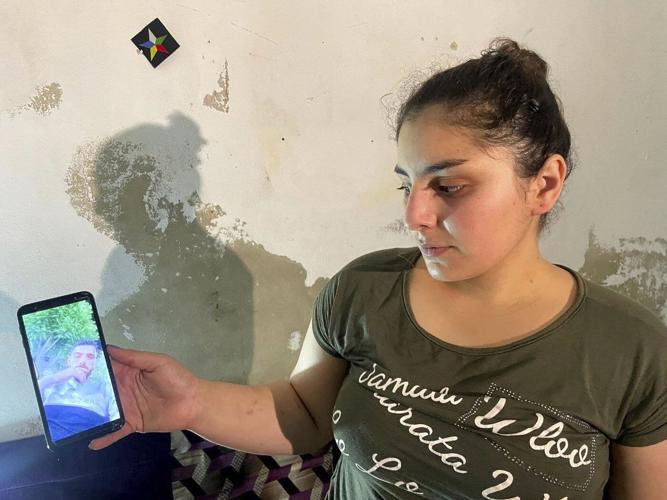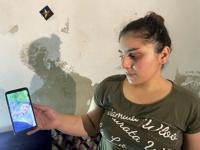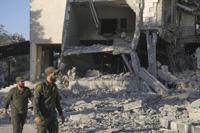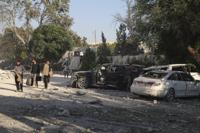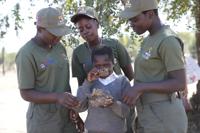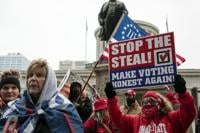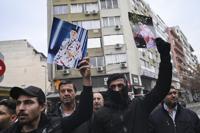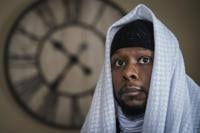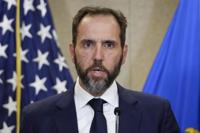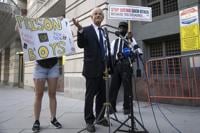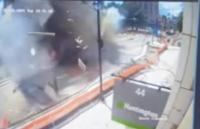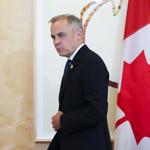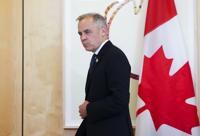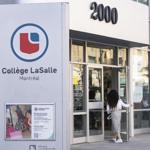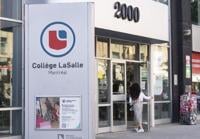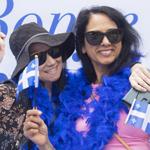JARAMANA, Syria (AP) — A Syrian Druze woman living in the United Arab Emirates frantically tried to keep in touch with her family in her hometown in southern Syria as clashes raged there over the past days.
Her mother, father and sister sent videos of their neighbors fleeing as fighters moved in. The explosions from shelling were non-stop, hitting near their house. Her family took shelter in the basement. When she reached them later in a video call, they said her father was missing. He had gone out during a lull to check the situation and never returned.
“Now I only pray. That’s all I can do," she told The Associated Press at the time.
Hours later, they learned he had been shot and killed by a sniper. The woman spoke on condition of anonymity fearing that using her name would put her surviving family and friends at risk.
A , easing days of brutal clashes in Sweida. Now, who fled or went into hiding are returning to search for loved ones and count their losses. They are finding homes looted and bloodied bodies of civilians in the streets.
‘Systemic killings’
The fighting began with tit-for-tat kidnappings and attacks between local Sunni Bedouin tribes and Druze militias in the majority-Druze Sweida province. Government forces that intervened to restore order , but also in some cases attacked civilians.
At least 600 people — combatants and civilians on both sides — were killed in four days of clashes, according to the Syrian Observatory for Human Rights, a Britain-based war monitor. It said the dead included more than 80 civilians, mostly Druze, who were rounded up by fighters and collectively shot to death in what the monitor called “field executions.”
“These are not individual acts but systemic,” the Observatory’s director Rami Abdul-Rahman told the AP. “All the violations are there. You can see from the bodies that are all over the streets in Sweida clearly show they’re shot in the head.”
In response, Druze militias have targeted Bedouin families in revenge attacks since the ceasefire was reached. Footage shared on Syrian state media shows Bedouin families putting their belongings in trucks and fleeing with reports of renewed skirmishes in those areas. There was no word on casualties in those attacks.
Most of the Syrian Druze who spoke to the AP requested anonymity, fearing they and their families could be targeted.
The is an offshoot of Ismailism, a branch of Shiite Islam. More than half of the roughly 1 million Druze worldwide live in Syria. The others live in Lebanon and Israel, including in the Golan Heights, which Israel captured from Syria in the 1967 Mideast War and annexed in 1981.
They largely celebrated the downfall in December of Syrian autocrat Bashar Assad but were divided over . The latest violence has left the community more skeptical of Syria’s new leadership and doubtful of peaceful coexistence.
Gunned down in the street
One Syrian-American Druze told the AP of his fear as he watched the clashes from the United States and tried to account for his family and friends whom he had seen in a recent trip to his native city Sweida.
Despite internet and communications breakdowns, he tracked down his family. His mother and brother fled because their home was shelled and raided, he said. Their belongings were stole, windows shattered. Their neighbors’ house was burned down. Two other neighbors were killed, one by shelling, another by stray bullets, he said.
He also pored over online videos of the fighting, finding a harrowing footage.
It showed gunmen in military uniform forcing a number of men in civilian clothes to kneel in the street in a well-known roundabout in Sweida. The gunmen then spray the men with automatic fire, their bodies dropping to the ground. The footage was seen by the AP.
To his horror, he recognized the men. One was a close family friend — another Syrian American on a visit to Sweida from the U.S. The others were the friend’s brother, father, three uncles and a cousin. Friends he reached told him that government forces had raided the house where they were all staying and took them outside and shot them.
“We affirm that protecting your rights and freedoms is among our top priorities,” al-Sharaa said in a speech broadcast Thursday, where he addressed the Druze people in Syria, promising to hold perpetrators of civilian killings to account.
But some rights groups accused Syria’s interim government of systematic sectarian violence, similar to that inflicted on the Alawite religious minority in the coastal province of Latakia in the aftermath of Assad's fall as the new government tried to quell a counterinsurgency there.
Footage widely circulated on social media showed some of the carnage. One video shows a living room with several bodies on the floor and bullet holes in the walls and sofa.
In another, there are at least nine bloodied bodies in one room of the home of a family that took in people fleeing the fighting. Portraits of Druze notables are visible, smashed on the floor.
Searching for her husband
Evelyn Azzam, a Druze woman, is searching the Damascus suburb of Jaramana, trying to find out what happened to her husband, Robert Kiwan.
Last week, the 23-year-old Kiwan left home in Jaramana early as he does every day to commute to his job in Sweida.
He got caught up in the chaos when the clashes erupted. Azzam was on the phone with him as government forces questioned him and his coworkers. She heard a gunshot when one of the coworkers raised his voice. She heard her husband trying to appeal to the soldiers.
“He was telling them that they are from the Druze of Sweida, but have nothing to do with the armed groups,” the 20-year-old Azzam said.
Then she heard another gunshot; her husband was shot in the hip. An ambulance took him to a hospital, where she later learned he underwent an operation. But she hasn’t heard anything since and doesn’t know if he survived.
Back in the U.S., the Syrian-American said he was relieved that his family is safe but the video of his friend’s family being gunned down in the street filled him with “disbelief, betrayal, rage.”
He said his family and friends protested against Assad, celebrated his downfall and wanted to give al-Sharaa’s rule a chance. He said he hadn’t wanted to believe that the new Syrian army — which emerged from al-Sharaa’s insurgent forces — was made up of Islamic militants.
But after the violence in Latakia and now in Sweida, he sees the new army as a “bunch of militias … with a huge majority being radicals.”
“I can’t imagine a world where I would be able to go back and integrate with these monsters,” he said.
___
Chehayeb reported from Beirut.

